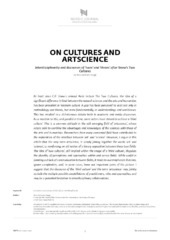On Cultures and Artscience. Interdisciplinarity and Discourses of “Twos” and “Threes” after Snow’s Two Cultures
Journal article, Peer reviewed
Published version

Åpne
Permanent lenke
https://hdl.handle.net/1956/11245Utgivelsesdato
2015Metadata
Vis full innførselSamlinger
Sammendrag
At least since C.P. Snow’s seminal Rede lecture The Two Cultures, the idea of a significant difference in kind between the natural sciences and the arts and humanities has been prevalent in Western culture. A gap has been perceived to exist not only in methodology and theory, but more fundamentally, in understandings and worldviews. This has resulted in a dichotomous debate both in academic and media discourses. As a reaction to this, and parallel in time, some actors have strived to achieve a ‘third culture’. This is a common attitude in the still emerging field of ‘artscience’, whose actors seek to combine the advantages and knowledges of the sciences with those of the arts and humanities. Researchers from every concerned field have contributed to the exploration of the interface between ‘art’ and ‘science’. However, I argue in this article that the very term artscience, in simply joining together the words ‘art’ and ’science’, is reenforcing an old notion of a binary opposition between these two fields. The idea of ‘two cultures’, still implied within the image of a ‘third culture’, disguises the plurality of perceptions and approaches within and across fields. While useful in pointing out lack of communication between fields, it tends to overemphasize divisions, ignore complexities, and, in some cases, leave out important parts of the picture. I suggest that the discourse of the ‘third culture’ and the term ‘artscience’ may jointly occlude the multiple possible constellations of practitioners, roles and approaches, and may be a potential limitation to interdisciplinary collaborations.
